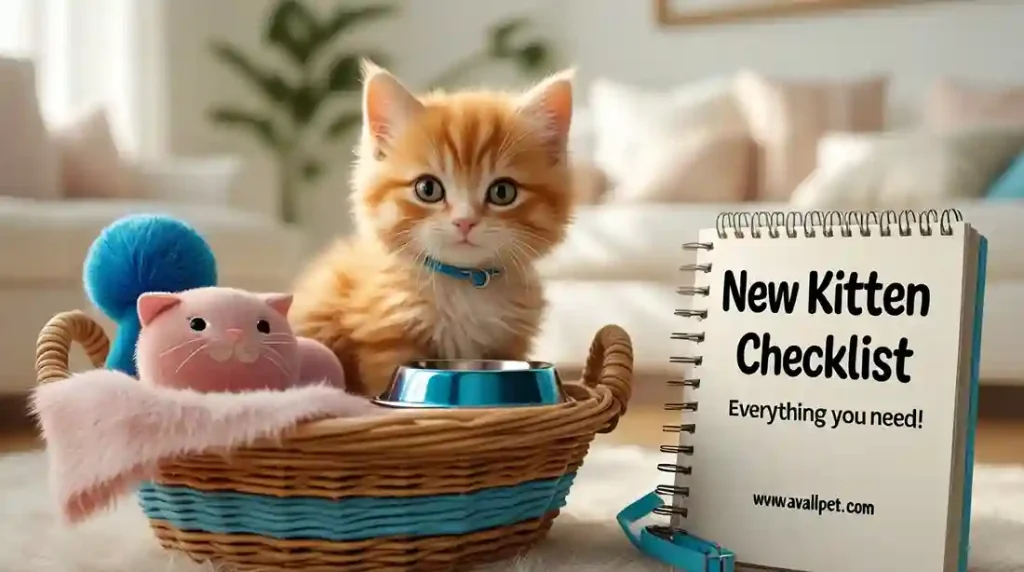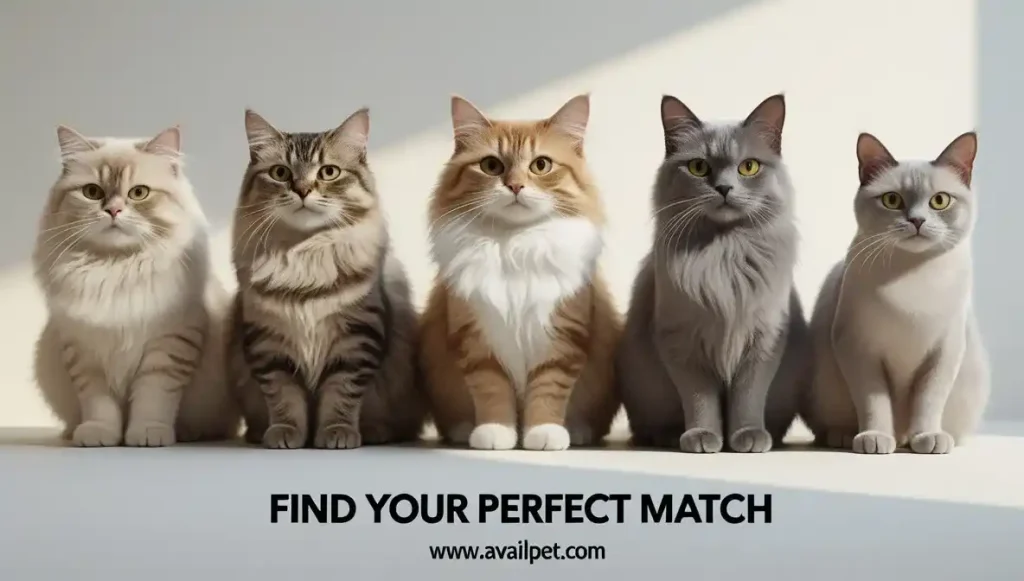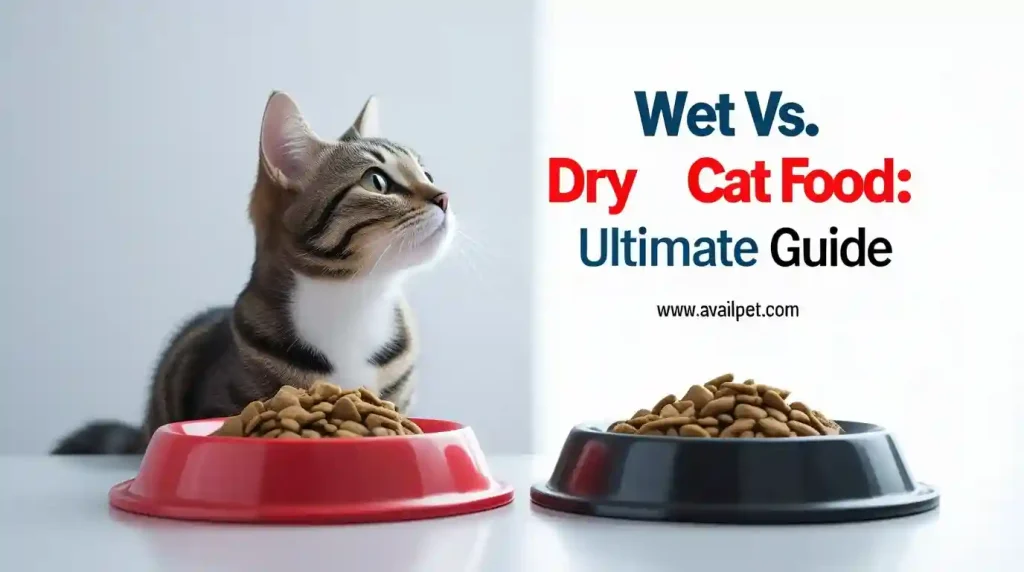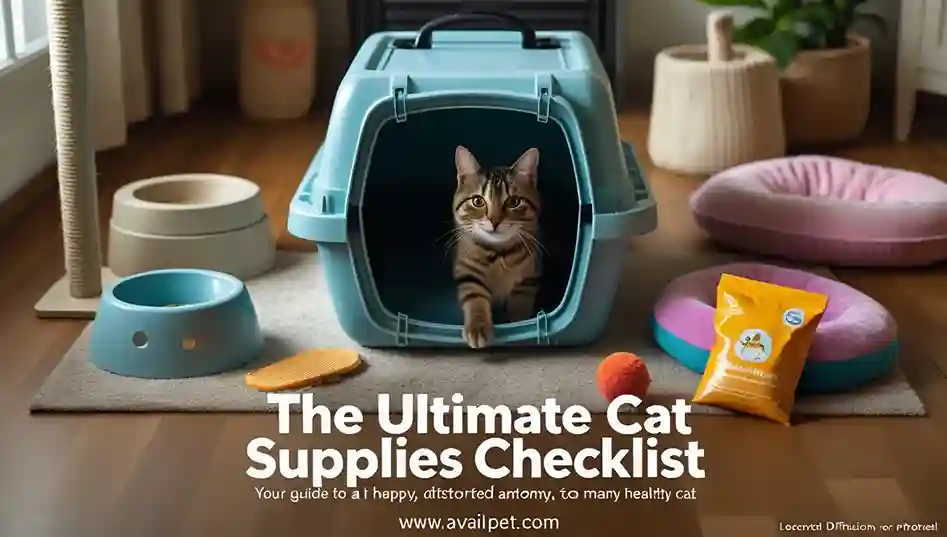Navigating the world of cat litter can feel like a choice between convenience and conscience. You want the superior odor control and easy cleanup you’re used to, but the environmental footprint of traditional clay litter—sitting in landfills for centuries—leaves you searching for a better way. The promise of “natural” cat litter offers an appealing solution, but does “eco-friendly” automatically mean effective?
The truth is, not all natural litters are created equal. Some form clumps that rival clay, while others turn into a sticky mess. Some neutralize odors with natural enzymes, while others simply mask them. Making the switch can be a significant adjustment for both you and your cat, and the wrong choice can lead to a frustrating—and smelly—experience.
At AvailPet, we’ve done the rigorous testing so you don’t have to. This definitive guide to the best natural cat litter of 2025 cuts through the greenwashing. We’ve evaluated the top plant-based options—from corn and pine to grass and wood—on clump strength, odor control, dust, and true sustainability, with insights from veterinary professionals. Our goal is to provide you with the clear, evidence-based information you need to find a litter that’s not only kind to the planet but also a pleasure to use.
Key Takeaways: Best Natural Cat Litter
Before we dive into the detailed reviews, here are the most important insights from our extensive testing and veterinary consultation:
- 🏆 Best Overall Natural Litter: World’s Best Cat Litter (Corn Formula) consistently delivered the best balance of rock-solid clumping, powerful odor neutralization, and low dust in a plant-based formula.
- 🌲 Best for Natural Odor Control (Non-Clumping): Feline Pine Original uses the natural power of pine to eliminate odors through absorption and has virtually no dust, making it ideal for cats and owners with respiratory sensitivities.
- 🚀 Best Clumping Performance: SmartCat Grass Seed Litter rivals premium clay litters with its exceptionally tight, hard clumps that resist sticking and crumbling, all made from renewable grass.
- 💨 Best Low-Dust & Lightweight: Ökocat Natural Wood Clumping Litter is a standout for its minimal dust and lightweight composition, offering excellent absorbency and easy handling.
- ⚠️ Vet-Reviewed Safety Note: While natural litters are often safer, they are not risk-free. Consult your veterinarian before switching kittens, as some plant-based materials can pose ingestion risks, and any litter can harbor mold if not stored or changed properly.
- 💡 Pro Transition Tip: To avoid litter box aversion, mix the new natural litter with your cat’s old litter over 7-10 days, starting with a 25%/75% mix and gradually increasing the ratio.
Quick Comparison Table: Our Top Natural Litter Picks at a Glance
This table provides a snapshot of our top-rated natural litters. For in-depth reviews and testing insights, jump to the detailed reviews section.
| Product | Primary Material | Clumps? | Dust Level | Weight | Check Price |
| World’s Best Cat Litter | Corn | Yes | Low | Medium | Check Amazon |
| Feline Pine Original | Pine | No | Very Low | Heavy | Check Amazon |
| SmartCat All Natural | Grass | Yes | Low | Light | Check Amazon |
| Ökocat Natural Wood | Wood | Yes | Very Low | Light | Check Amazon |
| Fresh News Recycled | Paper | No | Dust-Free | Heavy | Check Amazon |
What Makes a Cat Litter “Natural”? An Expert Breakdown
The term “natural” on a litter box can mean many things, but at its core, it signifies a fundamental shift away from synthetic chemicals and non-biodegradable materials. Unlike traditional clay litters, which are strip-mined from the earth, natural litters are typically derived from renewable, plant-based sources.
The “Natural” Standard:
A truly natural litter is characterized by:
- Plant-Based Materials: Sourced from fast-growing crops like corn, wheat, and grass, or byproducts like pine sawdust and recycled paper.
- Biodegradability: Designed to break down naturally in composting environments, unlike clay which remains in landfills indefinitely.
- Minimal Processing: Often free from synthetic fragrances, chemical deodorizers, and artificial clumping agents.
The Eco-Friendly Spectrum:
It’s crucial to distinguish between “natural” and “eco-friendly.” While all natural litters are more sustainable than clay, their environmental impact varies based on:
- Sourcing: Is the material a renewable crop or a manufacturing byproduct?
- Production Energy: The resources required to process the raw material.
- End-of-Life: Whether it can be safely composted at home or must be landfilled.
Honest Trade-Offs:
Switching to natural litter requires managing expectations. While excellent for the planet, they often present trade-offs:
- Clump Strength: May not be as rock-solid as premium clay litters.
- Cost: Typically more expensive per pound.
- Transition Period: Your cat may need time to adjust to new textures and scents.
Understanding these fundamentals ensures you choose a litter that aligns with both your environmental values and practical needs for a clean, odor-free home.
Our Top Natural Litter Picks: In-Depth Reviews
We tested the leading natural litters to give you a clear, unbiased look at their real-world performance. Here are our detailed reviews, complete with direct links to check prices from our trusted partners.
1. World’s Best Cat Litter (Corn Formula) — Best Overall
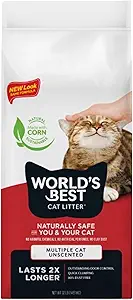
- Award: 🏆 Best Overall
- Key Specs: Material: Corn | Clumps: Yes | Dust Level: Low
Our In-Depth Analysis:
This corn-based litter earns its confident name by delivering the most well-rounded performance of any natural litter we tested. It forms remarkably solid clumps that hold together during scooping, rivaling many clay litters. The natural corn enzymes provide excellent odor control without perfumes, and it produces significantly less dust than clay alternatives. It’s also flushable* and lightweight, making disposal easier.
Pros:
- Forms strong, reliable clumps
- Excellent natural odor control
- Low dust and lightweight
- Flushable* and biodegradable
Cons:
- Premium price point
- Can track more than some heavier litters
- Always check local regulations before flushing
2. Feline Pine Original — Best for Natural Odor Control
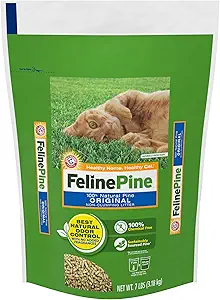
- Award: 🌲 Best for Natural Odor Control
- Key Specs: Material: Pine | Clumps: No | Dust Level: Very Low
Our In-Depth Analysis:
Feline Pine uses a unique non-clumping system that relies on the natural power of pine. When urine hits the pellets, they break down into sawdust that locks in moisture and neutralizes odor with natural pine enzymes. This process makes it incredibly effective at controlling ammonia smells and creates virtually zero dust. It’s an excellent choice for cats or owners with respiratory sensitivities.
Pros:
- Superior natural odor control
- Virtually dust-free
- Very affordable
- Natural, pleasant pine scent
Cons:
- Does not clump (requires sifting box)
- Some cats dislike the texture of pellets
- Heavy compared to other natural options
3. SmartCat All Natural Litter — Best Clumping Performance
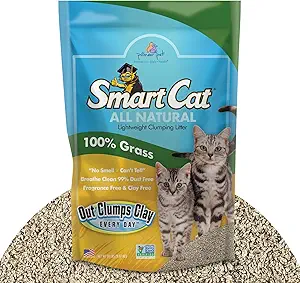
- Award: 🌾 Best Clumping Performance
- Key Specs: Material: Grass | Clumps: Yes | Dust Level: Low
Our In-Depth Analysis:
If clump strength is your top priority, this grass seed litter is unmatched in the natural category. It forms incredibly tight, hard clumps that rival premium clay litters, making scooping clean and efficient. The fine, soft texture is often preferred by cats transitioning from clay. It’s naturally low-dust and offers good odor control, though it may require more frequent changing in multi-cat households.
Pros:
- Forms rock-solid, clay-like clumps
- Soft texture cats love
- Very low dust
- Made from renewable US grass
Cons:
- Highest price point of our picks
- Can be softer clumps may stick to box
- Light weight means more tracking
4. Ökocat Natural Wood Clumping Litter — Best Low-Dust & Lightweight
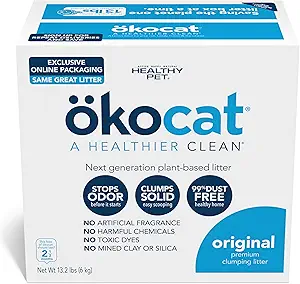
- Award: 💨 Best Low-Dust & Lightweight
- Key Specs: Material: Wood | Clumps: Yes | Dust Level: Very Low
Our In-Depth Analysis:
Made from reclaimed wood, Ökocat stands out for its exceptional dust control and lightweight composition. The natural wood fibers are highly absorbent, forming firm clumps while neutralizing odors effectively. It’s significantly lighter than clay litters yet offers better clumping than many natural alternatives. The larger particle size helps reduce tracking, making it a great balance of performance and cleanliness.
Pros:
- Extremely low dust
- Lightweight yet highly absorbent
- Good clump formation
- Sustainable wood sourcing
Cons:
- Wood texture may not appeal to all cats
- Higher price than conventional litter
- Can be messier than finer-textured litters
5. Fresh News Recycled Paper Litter — Best for Kittens & Recovery
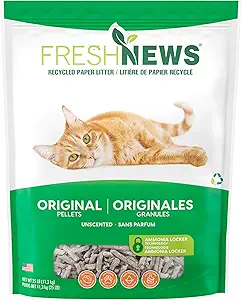
- Award: 📄 Best for Kittens & Recovery
- Key Specs: Material: Paper | Clumps: No | Dust Level: Dust-Free
Our In-Depth Analysis:
This recycled paper litter serves a specific but crucial purpose. Its dust-free composition makes it ideal for kittens, senior cats, and pets recovering from surgery where dust inhalation could complicate respiratory issues. The highly absorbent pellets are soft on paws and contain no fragrances or chemicals. While it doesn’t clump, it forms solid waste masses that are easy to remove while containing odors effectively.
Pros:
- 100% dust-free
- Soft and gentle on paws
- Highly absorbent
- Recycled material
Cons:
- Does not clump
- Requires more frequent full changes
- Can be expensive for daily use
Natural Litter Buyer’s Guide: How to Choose
Finding the right natural litter means balancing performance with your values. Use this guide to navigate the key differences and find the perfect match for your home.
1. Material Guide: Understanding Your Options
- Corn: Excellent clumping and odor control. Soft texture cats usually accept. Potential for mold if stored improperly.
- Wheat: Similar to corn, with good clumping. Natural enzymes break down waste. Can attract pantry pests if not stored securely.
- Grass: Forms very tight, clay-like clumps. Extremely low dust. Premium price point; may track due to light weight.
- Pine: Excellent natural odor control through absorption. Very low dust. Doesn’t clump; requires specific sifting litter box.
- Wood: Highly absorbent and low dust. Good clumping in some formulas. Texture may be unfamiliar to some cats.
- Paper: Completely dust-free. Soft and safe for post-surgery cats. Doesn’t clump; requires frequent changing.
- Walnut: Natural odor neutralization. Dark color helps hide stains. Can be dusty and may track noticeably.
2. Clumping vs. Non-Clumping in Natural Litters
Natural litters come in both forms. Clumping varieties offer familiar, easy cleanup but may not form as hard a clump as clay. Non-clumping options (like pine pellets) are often more affordable and excel at liquid absorption, but require a specific sifting box system. For a deeper dive into the mechanics, see our complete guide: Clumping vs. Non-Clumping Cat Litter: The Ultimate Guide.
3. Odor Control: How Natural Litters Manage Smell
Unlike clay litters that often use perfumes, natural litters control odor through:
- Absorption: Materials like pine and paper soak up moisture.
- Neutralization: Plant enzymes in corn and wheat break down ammonia.
- Sealing: Tight clumps (grass, corn) trap odor inside.
Learn more about the science of litter box smells in our Cat Litter Guide.
4. Dust & Health Considerations
While generally lower dust than clay, natural litters vary. Paper and pine pellets are virtually dust-free, making them ideal for cats with asthma. Fine-textured grass and corn litters may have some dust, though significantly less than clay.
5. Sustainability Metrics: What Truly Makes a Difference
Look beyond “natural” claims. A truly eco-friendly litter should have:
- Renewable sourcing (rapidly replenishing materials)
- Biodegradable or compostable end-of-life
- Minimal processing and manufacturing footprint
- Recyclable packaging
6. Cost Analysis: Understanding Long-Term Value
Natural litters typically cost more per bag than clay. However, some last longer due to high absorbency, making the cost-per-use more comparable. Consider both the initial price and how frequently you’ll need to replace it. Our Best Clumping Cat Litter guide includes a value analysis of conventional options for comparison.
How We Tested & Chose: Our Methodology
At AvailPet, we believe trust is built through transparency. Our recommendations are the result of a rigorous, multi-faceted methodology designed to evaluate natural litters on both performance and principle. Here’s how we ensure our “best” lists are truly the best.
Our Evaluation Framework
We scored each natural cat litter on a 100-point scale across these key performance indicators:
- Clump Quality & Strength (25 pts): For clumping varieties, we tested formation speed, firmness, and integrity. Did it hold together without crumbling or sticking to the box?
- Natural Odor Control (20 pts): We assessed how effectively each litter neutralized ammonia and fecal odors using plant-based materials, not perfumes, over a 24-hour period.
- Dust & Tracking (20 pts): We measured airborne dust during pouring and simulated digging, and evaluated how far particles were carried outside the box.
- Sustainability & Sourcing (20 pts): We analyzed material renewability, biodegradability, manufacturing transparency, and packaging environmental impact.
- Value & Longevity (15 pts): We calculated cost per use, analyzed coverage recommendations, and reviewed real-user feedback on product lifespan.
Beyond the Bench Tests: Our Commitment
Our process extends beyond physical testing to include crucial expertise and real-world data:
- Veterinary Consultation: Our selections were reviewed by a practicing DVM who provided critical insight into material safety, ingestion risks for kittens, dust-related respiratory concerns, and the validity of health claims for various natural materials.
- Aggregated User Experience Analysis: We analyzed hundreds of verified customer reviews from major retailers to identify consistent performance patterns and real-world usage feedback.
- Sustainability Verification: We prioritized brands with transparent sourcing practices, credible certifications, and honest communication about their environmental footprint.
This comprehensive approach ensures our recommendations are evidence-based solutions you can trust for your pet’s health and your environmental values.
The Reality Check: Health, Safety & Transitioning
Choosing a natural litter is a great step, but a successful switch requires understanding a few real-world challenges. Being prepared ensures a positive experience for both you and your cat.
Health & Safety Considerations
While natural litters are generally safer, they aren’t risk-free. Our veterinary consultant highlighted these key points:
- Mold Risks: Plant-based litters (corn, wheat, grass) can develop mold if stored in damp areas or left in the box too long. Always store litter in a cool, dry place and scoop daily.
- Ingestion Risks: Curious kittens may try to eat litter. While less dangerous than clumping clay, ingested natural litter can still cause intestinal upset. Monitor young kittens closely and consult our [Kitten-Safe Litter Options] article for tailored advice.
- Allergies & Sensitivities: Just like people, cats can have allergies. Some may be sensitive to the dust or natural oils in pine, grass, or corn. Watch for signs of sneezing, itchy skin, or litter box avoidance.
- Dust & Respiratory Health: Though typically low-dust, some natural litters still produce particles. If your cat has asthma, paper or pine pellets are the safest choice. Learn more in our guide to [Respiratory Health in Cats].
The Transition Guide: Switching Litters Successfully
Cats are creatures of habit. A sudden change can cause litter box aversion. Follow this vet-approved method:
- Start Small: Mix 25% new natural litter with 75% old litter.
- Go Slow: Every 2-3 days, increase the new litter by 25%.
- Be Patient: A full transition should take 7-10 days.
- Use Multiple Boxes: If possible, offer one box with the old litter and one with the new mix.
- Watch for Signals: If your cat avoids the box, slow down the transition.
For more detailed strategies on solving litter box issues, our Cat Litter Guide Pillar covers common problems and solutions.
FAQs Best Natural Cat Litter
Is natural cat litter better for cats?
It depends on your priorities. Natural litter is typically better for the environment, is often lower in dust, and avoids synthetic chemicals, which can benefit cats with respiratory or skin sensitivities. However, some cats may dislike the texture of certain natural materials, and there can be minor risks like mold in plant-based litters if not maintained properly.
Can you flush natural cat litter?
We strongly advise against it. Even litters marketed as “flushable” can cause plumbing blockages as they are designed to clump and absorb moisture. Furthermore, cat feces can contain parasites like Toxoplasma gondii that are not reliably removed by water treatment and can harm marine ecosystems. The safest disposal method is scooping into a biodegradable bag and placing it in your trash.
Does natural litter control odor as well as clay?
It can, but through different mechanisms. High-quality natural litters like corn and grass excel at clumping and sealing odor inside, similar to clay. Others, like pine, use natural enzymes and absorption to neutralize smells.
Can you compost natural cat litter?
This requires extreme caution. You should only compost litter from a healthy, indoor-only cat and never use the compost on edible plants due to potential pathogens like Toxoplasma. Plant-based litters (corn, wheat, pine) are the best candidates, but dedicated, hot composting systems are needed to break down pathogens safely. We are developing a full guide on [Composting Cat Litter Safely] to cover this complex process.
Why is my cat avoiding the new natural litter?
This is common. Cats can be hesitant due to the new texture, scent, or feel under their paws. The most likely cause is switching too quickly. Please refer to the Transition Guide in the section above. If the problem persists after a gradual switch, your cat may simply dislike that specific material, and trying a different type (e.g., grass instead of pine) may be necessary.
Conclusion: Your Guide to a Greener, Cleaner Litter Box
Making the switch to natural cat litter is a meaningful step toward a more sustainable and health-conscious home. While no litter is perfect, the options available today offer a powerful combination of environmental responsibility and genuine performance that can meet—and often exceed—the standards of traditional clay.
Your perfect match depends on your top priority:
- For the best all-around performance that seamlessly blends clumping, odor control, and eco-friendliness, World’s Best Cat Litter (Corn) is your ideal choice.
- If superior odor neutralization and minimal dust are your goals, the natural power of Feline Pine (Pine) is unmatched.
- For those who prioritize clump strength above all else, SmartCat Grass Seed Litter proves that natural materials can compete with the best clays.
Remember, the most sustainable litter is the one your cat will actually use. A gradual transition is key to success. We encourage you to use the links throughout our reviews to check current prices and find the right natural litter to start your journey toward a fresher home and a lighter planetary pawprint.
Sources
- AVMA – Toxoplasma
- Cornell Feline Health Center – Feline Asthma
- International Association of Certified Home Inspectors – Mold Prevention
- World’s Best Cat Litter
- Feline Pine
- SmartCat Grass Litter
- Ökocat Natural Litter
- Yesterday’s News
- EPA Composting Guidelines
- Amazon Natural Litter Best Sellers
Disclaimer: Our recommendations are based on independent testing, research, and veterinary guidance. Product information and pricing are subject to change. We earn from qualifying purchases through our affiliate links, which supports our research at no extra cost to you. We are not veterinarians; always consult your vet for advice on your cat’s specific health needs, especially regarding litter choices for kittens or cats with medical conditions.

